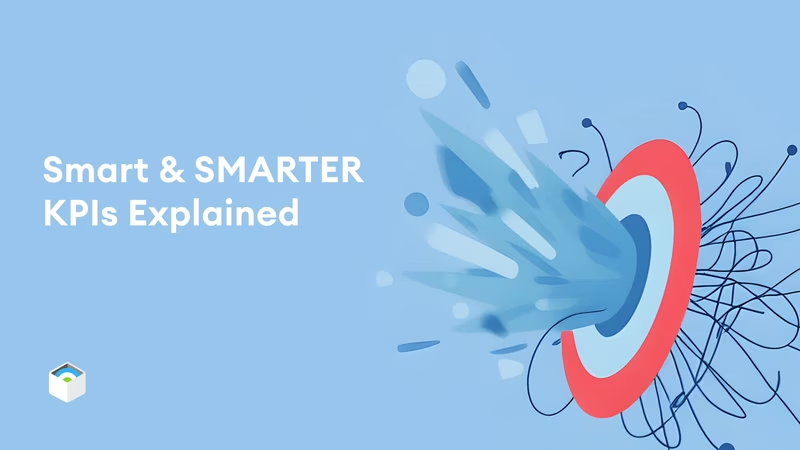It's easy to get lost in the world of management fads and business jargon. Quick fixes and complex methodologies, the compulsion to buy into the 'next big thing' is relentless. Performance management is no different, with a variety of frameworks promising guaranteed growth.
One persistent and widely adopted concept is SMART criteria, often applied to Key Performance Indicators (KPIs). But is 'SMART KPI' even the right term? Some experts argue that SMART applies to *objectives* or *goals*, not the KPIs that *measure* progress towards those goals. This distinction can cause confusion.
Let's cut through the noise. This article explores the standard SMART framework, introduces the enhanced SMARTER model, clarifies the goal vs. KPI relationship, and gives you practical steps and examples to define meaningful metrics for your KPI dashboards. Whether you call them SMART KPIs or SMART goals measured by KPIs, these principles are key for effective performance tracking.
In this article:
- What are SMART KPIs?
- A Brief History of SMART
- Where are SMART Criteria Applied?
- What's the Difference Between KPIs and SMART Goals?
- Benefits of Using SMART Criteria for Your KPIs
- Common SMART KPI Misconceptions
- The Relationship Between KPIs and Business Data
- SMART KPI Examples Across Departments
- Step-by-Step Guide to Creating SMART KPIs
- Getting Even SMARTER: Evaluate and Revise
- SMARTER in Action: A Real-World Example
- Real-World Success: SMARTER KPIs in Action
- Final Thoughts
What are SMART KPIs?
A SMART Key Performance Indicator (KPI) is a performance metric that is set up to be Specific, Measurable, Achievable, Relevant, and Time-bound. The format transforms broad goals into focused, actionable targets so the objective being measured is well established and progress can be readily quantified. For instance, rather than a general objective such as "enhance sales," a SMART KPI objective would be "Boost sales revenue by 10% in Q3 2023," defining the metric (sales revenue), the objective (10% growth), and the period (Q3 2023).
You know, there's always this debate about whether the KPI or the objective that it is linked to needs to pass the SMART test. Technically, a KPI is just a measurement (e.g., 'website conversion rate'), while a SMART goal is the actual outcome you're trying to achieve through that measurement (e.g., 'Increase website conversion rate from 2% to 3% by end of Q3'). Goals define the outcome you're aiming for ('Did we get X?'), while KPIs measure progress and performance on a continuum ('At what rate are we going?').
However, in practical application, the term "SMART KPI" is frequently used as shorthand to signify that the target or objective being measured by the KPI has been defined using the SMART principles. This structured approach helps replace guesswork with precision in tracking performance.
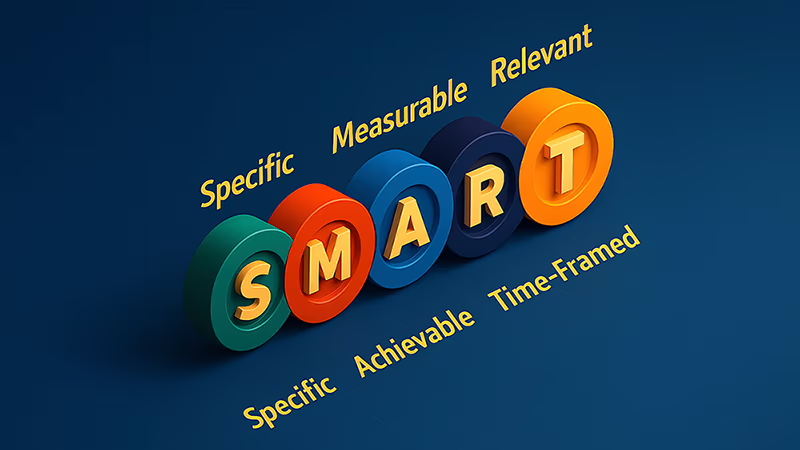
- Specific: Be specific as to what you wish to achieve. What is the actual objective? Do not use jargon.
- Measurable: In what way will success and progress be quantified? What is the measurement unit? Ensure that the KPI itself can be measured.
- Achievable: Is the goal realistic in terms of your resources, time, and market conditions? Establish challenging yet attainable goals.
- Relevant: When should the objective be achieved? Setting deadlines creates urgency and aids planning.
- Time-bound: When should the objective be achieved? Setting deadlines creates urgency and aids planning.
They help you to set realistic performance goals that are aligned within the overall business strategy, whether you are looking at them on dashboards or KPI Reports
A Brief History of SMART
The SMART criteria concept, while widely used today, isn't new, gaining prominence following George T. Doran's November 1981 paper titled "There's a S.M.A.R.T. Way to Write Management's Goals and Objectives." Although variations exist and attributions are sometimes incorrectly made to Peter Drucker due to his related work on Management by Objectives, Doran, a consultant and former Director of Corporate Planning, initially presented the framework as a way for managers to define clearer goals, noting that not every objective would necessarily meet all five criteria (his original definition included Assignable and Realistic).
Fundamentally designed as a practical checklist to transform vague aspirations into actionable management objectives and address goal ambiguity, its simplicity and power led to its widespread adoption beyond its initial scope.
It is being broadly applied now in areas like employee performance management and KPI setup to help businesses enhance clarity, focus, accountability, and alignment, thereby goal achievement rates and morale by providing clear standards.
Where are SMART Criteria Applied?
SMART criteria are extremely flexible. Though typically addressed in terms of general business strategy and performance management, they are successfully applied in:
- Project Management: defining project objectives and milestones
- Marketing Campaigns: setting lead generation, conversion rate, and brand awareness goals
- Sales Targets: setting quotas, pipeline objectives
- Customer Service Improvements: response rates, satisfaction scores
- Finance: budget adherence, cost reduction targets
- Human Resources: hiring timelines, training completion rates, employee retention rates
- Product Development: feature launch timelines, bug reduction targets
- Personal Development Plans
Basically, anytime you've got to set a clear goal that you can track, the SMART framework is super helpful.
What's the Difference Between KPIs and SMART Goals?
Let's refine the distinction: A Key Performance Indicator (KPI) is a measurement of performance or progress toward a key business objective. Examples: Customer Acquisition Cost, Website Traffic, Employee Turnover Rate.
A SMART Goal is a specific objective that you want to achieve, expressed in terms of the SMART criteria. The objective is typically one related to improving a specific KPI.
Think of it like this:
KPI: The speedometer on your vehicle (tracks speed).
Mission: Get to that location 200 miles distant.
SMART Goal: Maintain a speed of approximately 60 mph (Measurable, Achievable, Relevant) so that I arrive where I am going (Specific) within 3 hours and 20 minutes (Time-bound), monitoring it using the speedometer (the KPI).
So, while a KPI is just a measurement, using SMART principles helps you set meaningful targets for the measurement.
Benefits of Using SMART Criteria for Your KPIs
Setting your KPI targets based on the SMART model is not a matter of box-checking; it has real advantages:
- Clarity and Focus: Eliminates confusion. All concerned know the exact goal, how it is being quantified, and the timeframe.
- Improved Alignment: Ensures that team activities and individual objectives make a direct impact on larger business objectives (Relevance).
- Greater Motivation: Challenging yet achievable goals can motivate teams. Visible metrics provide feedback on progress.
- Enhanced Accountability: It is easier to track progress and hold individuals or groups accountable when goals are specific and measurable.
- Effective Resource Allocation: Knowledge of the clear goals and deadlines enables better budget, time, and personnel allocation.
- Data-Driven Decision Making: SMART goals ensure clear criteria on which to base performance and data-driven decisions.
- Simplified Communication: Facilitates discussing performance and progress significantly and makes it more objective.
Key Takeaway: The application of SMART criteria transforms vague desires into solid, quantifiable objectives that energize performance and alignment.
Common SMART KPI Misconceptions
Despite its popularity, the SMART model is occasionally misplaced or misapplied:
- "KPIs must be SMART": As we covered, it's generally the goal or target related to the KPI that must be SMART. The KPI itself is merely how we measure it.
- "Making a SMART goal guarantees achievement": SMART provides discipline, yet effort, planning, and perhaps adapting to changing circumstances are still required to fulfill it.
- "Attainable means 'easy'": Attainable is realistic, not easy. Goals must stretch ability without being demoralizingly impossible.
- "Relevant means relevant just for the team": Relevance should actually relate all the way up to the grand company objectives.
- "Time-limited is 'as soon as possible'": You really do need a clear, attainable deadline, not a general sense of urgency.
- "Once set, SMART goals are rigid": This is where the 'ER' in SMARTER comes in. Goals may need evaluation and revision.
Knowing these subtleties aids in the practical application of the framework.
The Relationship Between KPIs and Business Data
KPIs do not live in a vacuum; they are necessarily reliant on having available correct and usable business information. Think of data as the raw material and KPIs as the refined indicators that are drawn from it.
- Data is the Building Block: When attempting to quantify a KPI (e.g., 'Monthly Recurring Revenue'), you need valid underlying data (customer subscription records, payment amounts, dates).
- KPIs Provide Context: Raw data (i.e., a list of sales orders) can be overwhelming. KPIs boil down data into actionable context (i.e., 'Average Deal Size', 'Sales Growth Rate').
- Data Quality Matters: Your KPIs will be incorrect if your underlying data is incomplete, incorrect, or inconsistent. As the saying goes, "Garbage in, garbage out."
- Data Accessibility Matters: Teams require access to the data necessary to compute and track their KPIs in a timely manner. This typically requires data integration across disparate systems (CRM, finance, marketing automation).
- Visualization Bridges Data and KPIs: Tools like KPI dashboard software are a true game-changer in turning raw data into easy-to-comprehend KPI visuals, accentuating trends and performance gaps in plain sight.
Therefore, a successful KPI strategy requires a solid data management strategy underpinning it.
SMART KPI Examples Across Departments
Let's look at how to apply SMART criteria to common KPIs in different business areas. Remember, the KPI is the metric, and SMART defines the target.
Sales Team Example
Transforming a vague goal into a SMART one:
- Vague Goal: Increase sales.
- KPI: Sales Revenue ($)
-
SMART Goal:
- Specific: Increase total sales revenue from new customers.
- Measurable: Achieve $50,000 in new customer sales revenue.
- Achievable: Based on Q1 performance ($40k) and projected lead increase, $50k is challenging but attainable.
- Relevant: Directly contributes to the company's overall revenue growth objective.
- Time-bound: By the end of Q2 2024.
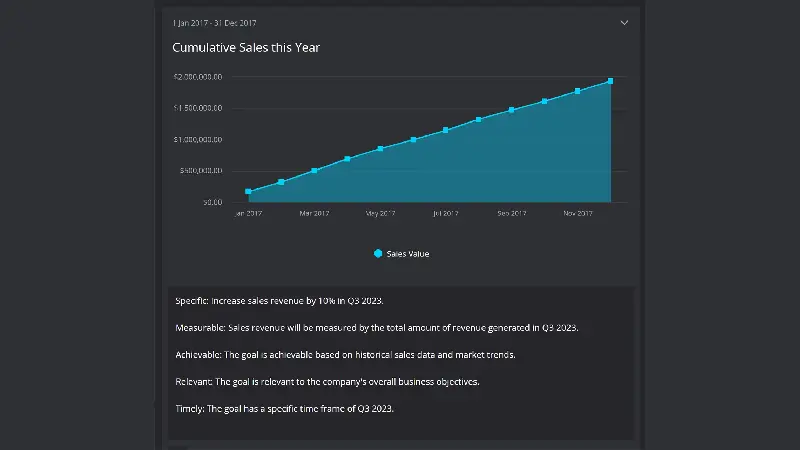
Need more examples? Check out this Sales KPI Dashboard Example for inspiration.
Marketing Team Example
- Vague Goal: Improve website engagement.
- KPI: Website Lead Conversion Rate (%)
-
SMART Goal:
- Specific: Increase the conversion rate of website visitors to demo requests via the main landing page form.
- Measurable: Increase the rate from the current 1.5% to 2.5%.
- Achievable: Based on planned A/B testing and improved CTA copy, a 1% increase is feasible.
- Relevant: Supports the sales team's goal by providing more qualified leads.
- Time-bound: Within the next 60 days.
Need more examples? Check out this Marketing KPI Dashboard Example for inspiration.
Customer Service Example
- Vague Goal: Make customers happier.
- KPI: Customer Satisfaction Score (CSAT %)
-
SMART Goal:
- Specific: Increase the average Customer Satisfaction (CSAT) score reported via post-interaction surveys.
- Measurable: Increase the average CSAT score from 85% to 90%.
- Achievable: Achievable through implementing the new agent training program and faster internal escalation process.
- Relevant: Directly impacts customer retention and brand reputation.
- Time-bound: By the end of the fiscal year.
Need more examples? Check out this Customer Service KPI Dashboard Example for inspiration.
Step-by-Step Guide to Creating SMART KPIs
Ready to set your own SMART goals? Here's a step-by-step process that follows our simple approach:
- Set Major Business Objectives: What are the highest-level strategic imperatives for the department or company currently? Start broad. (Think big picture first!).
- Select Appropriate KPIs: Select the KPIs that best measure progress against those objectives. Don't measure everything, just the key ones. (Getting stuck? Check out our guide to choosing the best KPIs).
- Set a Baseline: What is your current performance level for your chosen KPI? You can't really set a decent target without knowing where you're starting.
-
Write the Goal - Use SMART:
- Specific: Be precise about what has to improve and by how much.
- Measurable: Define the exact metric and unit. How will you track it?
- Achievable/Realistic: Assess resources, previous trends, and potential barriers. Is the objective realistic? Discuss with the team responsible.
- Relevant: Verify alignment with the overall business objective defined in step 1.
- Time-bound: State a clear deadline or time limit.
- Assign Ownership: Who is responsible for achieving this target? Clear accountability is crucial.
- Communicate Clearly: Ensure that everyone involved knows the SMART goal, why it is important, and how it will be tracked. Keep it straightforward!
- Integrate into Dashboards: Add the KPI and SMART target to your KPI dashboards for easy monitoring.
- Review Regularly (See SMARTER): Instead of set and forget, incorporate regular review sessions to check progress and adjust accordingly.
Key Takeaway: The development of SMART KPI targets is a circular process starting with strategic objectives and requiring explicit communication and regular review.
Getting Even SMARTER: Evaluate and Revise
The business environment is dynamic. What was relevant or achievable last quarter might not be today. This is where the 'ER' in SMARTER comes in, extending the framework for ongoing effectiveness:
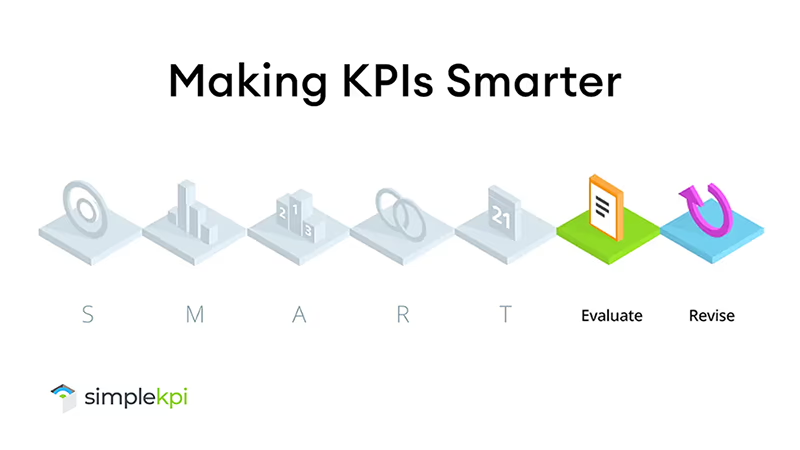
-
Evaluate: Regularly assess your KPIs and their associated SMART goals. Ask questions like:
- Is this KPI still relevant to our current strategic objectives?
- Is the data accurate and easy to obtain?
- Is the target still appropriately challenging (not too easy, not impossible)?
- Are we seeing the expected progress? Why or why not?
- Are there external factors (market changes, new competitors) impacting performance?
-
Revise: Based on your evaluation, be prepared to adjust. This could mean:
- Changing the target value (up or down).
- Adjusting the timeframe.
- Modifying the KPI itself if it's no longer the best measure.
- Changing the strategy or tactics used to achieve the goal.
- Stopping tracking a KPI if it's no longer relevant.
The SMARTER approach turns goal setting from a one-time event into a continuous improvement cycle.
SMARTER in Action: A Real-World Example
Let's revisit the Customer Retention Rate (CRR) example for a subscription business. High CRR is vital for sustainable growth.
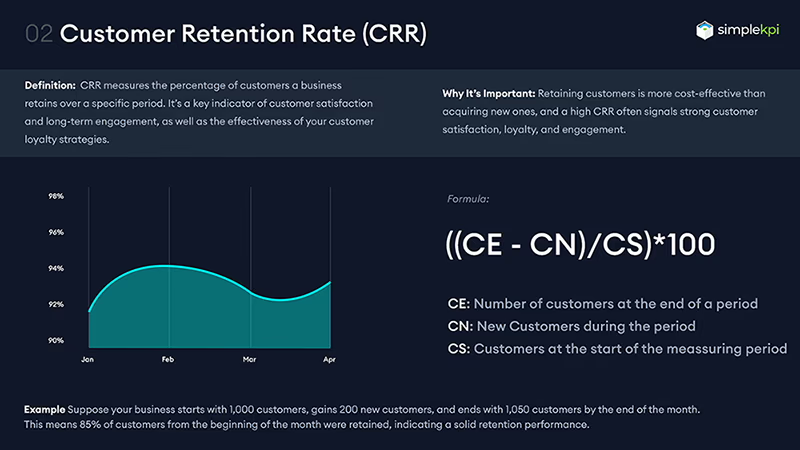
Initial Business Objective: Reduce customer churn and improve long-term revenue.
KPI: Customer Retention Rate (CRR), calculated monthly.
Initial SMART Goal: Increase CRR from 88% (current baseline) to 92% within 12 months.
Applying the SMARTER criteria over time:
- Specific: Increase CRR. (Target: 92%).
- Measurable: Use the standard CRR formula: `(((Customers at End Period - New Customers Acquired) / Customers at Start Period)) * 100`. Track monthly[1].
- Achievable: Initial analysis suggested 92% was possible with planned initiatives (improved onboarding, loyalty program).
- Relevant: Directly supports the objective of reducing churn and boosting long-term revenue.
- Time-bound: Achieve the 92% target within 12 months.
- Evaluate (After 6 months): Monthly tracking shows CRR increased to 90%, but progress has stalled. A major competitor launched a significantly cheaper offering 2 months ago, impacting cancellations. The initial initiatives are working, but external factors have changed. The original 92% target now seems overly optimistic without further action.
-
Revise (The important step!): Based on the evaluation, the team needs to adjust.
- Option 1: Adjust the target down to 91% for the original 12-month timeframe, acknowledging the market shift.
- Option 2: Keep the 92% target but extend the timeframe to 18 months and allocate resources to develop new competitive differentiators or targeted win-back campaigns.
- Decision: The team decides Option 2 aligns better with long-term strategy. The goal is revised: "Achieve 92% CRR within 18 months by implementing new, specific initiatives."
This shows how Evaluate and Revise keep the goal relevant and realistic in a changing environment, embodying the lean and smart approach.
Real-World Success: SMARTER KPIs in Action
Let's look at how real teams put SMARTER principles into practice.
Example Case Study 1: Tech Startup Boosts Lead Quality
A SaaS startup was tracking 'Marketing Qualified Leads' (MQLs) but sales complained about lead quality. They implemented a SMARTER goal:
- KPI: MQL-to-SQL (Sales Qualified Lead) Conversion Rate.
- SMART Goal: Increase MQL-to-SQL rate from 15% to 25% in 6 months by refining lead scoring criteria and improving marketing-sales alignment.
- Evaluate/Revise: After 3 months, the rate hit 20%. Evaluation showed scoring changes were effective, but alignment meetings needed better structure. They revised tactics, implementing a shared dashboard.
- Result: Achieved 26% MQL-to-SQL rate within 7 months, significantly improving sales efficiency.
Example Case Study 2: Retailer Reduces Cart Abandonment
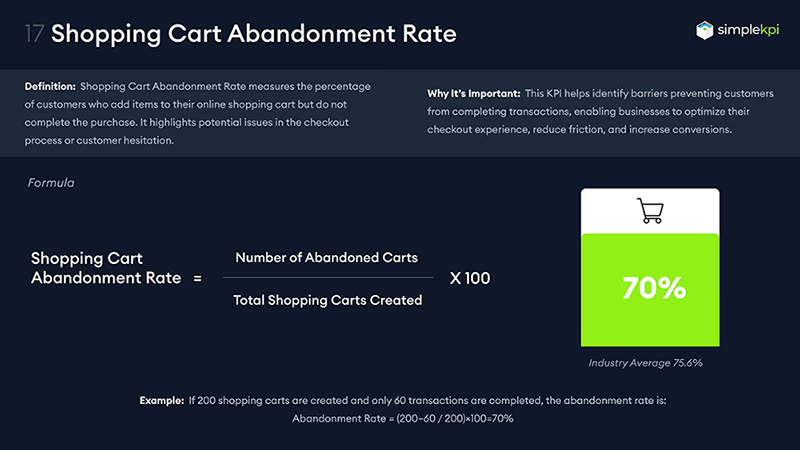
- KPI: Shopping Cart Abandonment Rate (%).
- SMART Goal: Reduce cart abandonment rate from 70% to 60% within 3 months by implementing a simplified checkout process and exit-intent pop-up offer.
- Evaluate/Revise: After 1 month, the rate dropped to 65%, but analytics showed the pop-up offer had a low conversion rate. They evaluated the offer's relevance and revised it to provide a tiered discount based on cart value.
- Result: Reached a 58% abandonment rate within the 3-month timeframe.
Final Thoughts
Whether you call them SMART KPIs or SMART goals measured by KPIs, applying the Specific, Measurable, Achievable, Relevant, and Time-bound criteria is fundamental for turning vague intentions into actionable targets. This structure brings clarity, focus, and accountability to your performance management efforts – without the usual headache.
Furthermore, embracing the SMARTER approach-by regularly Evaluating your progress and context, and being willing to Revise your goals-ensures your KPIs remain dynamic and aligned with your evolving business landscape. It fosters a culture of continuous improvement, helping you stay lean and agile.
By carefully defining, tracking, and evaluating your key metrics using these principles, you empower your teams to make better decisions, optimize performance, and ultimately drive meaningful results visible on your Simple KPI dashboards.

by Stuart Kinsey
Stuart Kinsey writes on Key Performance Indicators, Dashboards, Marketing, and Business Strategy. He is a co-founder of SimpleKPI and has worked in creative and analytical services for over 25 years. He believes embracing KPIs and visualizing performance is essential for any organization to thrive and grow.
